Table of Contents
Introduction
Sleep Medicine Statistics: Sleep medicine is a medical field focused on diagnosing and treating sleep-related disorders.
It deals with various issues like insomnia, sleep apnea, narcolepsy, and restless legs syndrome. Diagnosis involves tests like sleep studies, while treatments range from lifestyle changes to medications.
Collaboration with other medical specialties is common in addressing sleep disorders, and research in this field is ongoing.
Public health awareness and access to care are important aspects, and the field is evolving with emerging trends and technology.
Sleep medicine plays a vital role in improving individuals’ overall health and quality of life by addressing sleep-related issues.
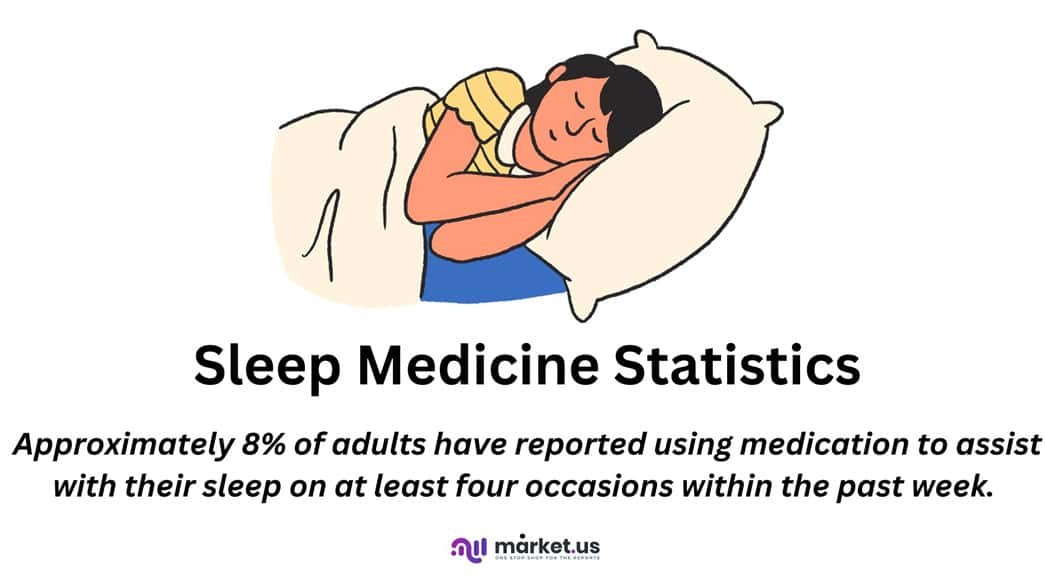
Editor’s Choice
- Sleep Apnea Devices Market was valued at USD 8.1 Billion. This Market is estimated to reach USD 16.0 Billion in 2032
- Approximately 8% of adults have reported using medication to assist with their sleep on at least four occasions within the past week.
- Approximately 20% of adults opt for marijuana or cannabidiol (CBD) to aid their sleep, and 23% have turned to Benadryl (diphenhydramine) as a sleep aid in the past month.
- In individuals aged less than 60 years, the prevalence of sleep disorders stands at 17.2%. While those without sleep disorders make up 43.3% of this age group.
- According to a survey conducted by SleepFoundation.org, 58% of individuals with seasonal affective disorder rely on sleep aids, while only 26% of those without the disorder use them.
- Additionally, 79% of adults who take prescription sleep medication encounter lingering effects such as excessive sleep, grogginess, or difficulty concentrating the following day.
- Among adults aged 18-24, approximately 40% have reported using sleep medications. While the prevalence is slightly higher in the 25-34 age group at 45%.
- The NIH’s commitment to sleep research remains evident, with funding projected to reach 544 million USD in 2023 and 555 million USD in 2024.
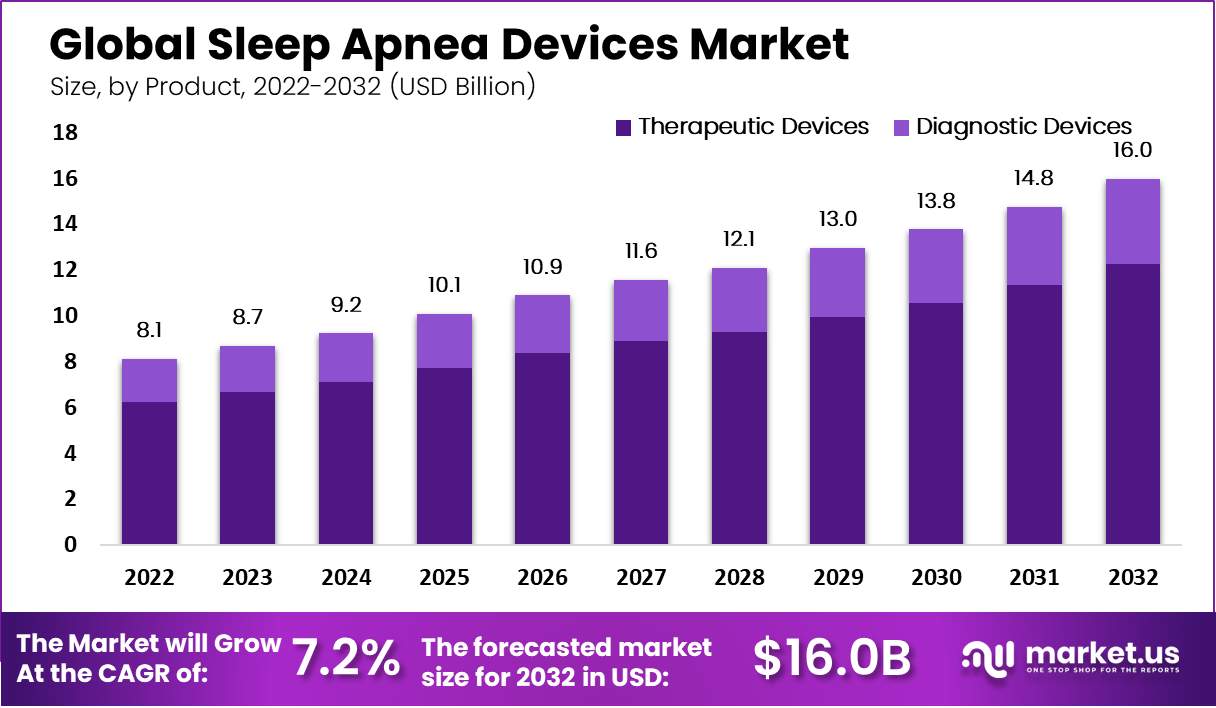
Prevalence of Sleep Medicine Disorders Statistics
Insomnia
- Between 30% to 50% of adults may experience occasional short-term insomnia during their lives.
- According to the American Academy of Sleep Medicine (AASM), in adults experiencing insomnia, about 30-35% have brief episodes of insomnia.
- Approximately 15-20% encounter short-term insomnia that persists for less than three months.
- Around 10% grapple with a chronic insomnia disorder, enduring it at least three times a week for a minimum of three months.
- Insomnia symptoms are prevalent among older adults, with up to 75% of those aged 65 and above experiencing them.
- Women are more likely to report insomnia symptoms, with about 25% of women affected compared to 20% of men.
- Among children, approximately 20% exhibit insomnia symptoms, with the highest occurrence seen in preteen girls.
- Scientists approximate that the collective impact of insomnia on the U.S. workforce results in an economic burden of approximately $63 billion.
(Source: CDC, American Academy of Sleep Medicine (AASM), Springer, Office on Women’s Health, Science Direct, America Insomnia Institute)
Sleep Apnea
- Around 39 million adults in the United States are affected by obstructive sleep apnea (OSA). The global estimate for mild to severe OSA is approximately 936 million adults.
- In up to 94% of cases, snoring is a prevalent symptom of sleep apnea. If left untreated, sleep apnea can result in health complications concerning the heart, kidneys, and metabolism.
- In 2019, research was funded by ResMed, a manufacturer of sleep apnea treatment machines. It revealed that nearly 936 million adults worldwide experience mild to severe obstructive sleep apnea (OSA).
- Over two decades from 1993 to 2013, there were notable changes in the prevalence of obstructive sleep apnea (OSA) among U.S. adults aged 30 to 70 years old.
- Among men, the prevalence increased from 9% in 1993 to 13% in 2013, representing a substantial 27% increase.
- Similarly, among women, the prevalence also saw an upward trend. Rising from 4% in 1993 to 5% in 2013, marking a 25% increase.
- These figures highlight the growing awareness and diagnosis of OSA over time. With both genders experiencing an increased recognition of this sleep disorder.
- Sleep apnea diagnosis is more common among older individuals aged 50 to 70 compared to other age brackets. This heightened prevalence in this age group can be attributed to physiological changes that impact the throat and neck region as people age.
- Specifically, some older adults may develop greater deposits of fat around the throat. Which can increase the likelihood of airflow obstruction during sleep.
(Source: National Council on Aging, Lancet, National Council on Aging)
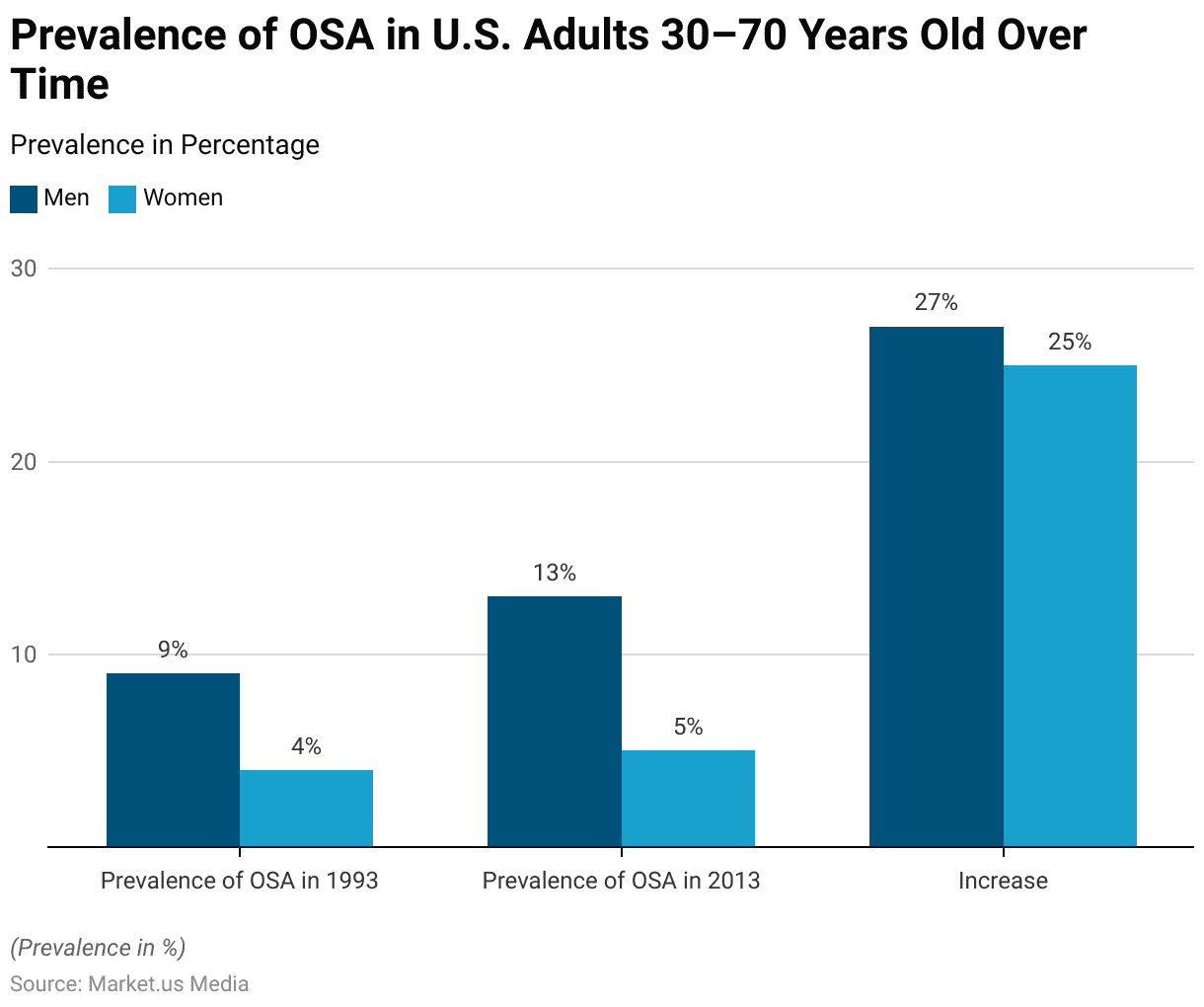
Restless Legs Syndrome (RLS)
- Roughly 7-10% of the U.S. population is believed to experience Restless Legs Syndrome (RLS), a condition that can onset at any stage of life. It affects both males and females, with a somewhat higher likelihood in females.
- Many individuals who suffer severely from RLS are in their middle age or older, and as they age, the symptoms tend to become more frequent and endure for longer durations.
- Over 80% of individuals with Restless Legs Syndrome (RLS) also encounter periodic limb movement during sleep (PLMS).
- PLMS involves involuntary twitching or jerking movements in the legs (and occasionally the arms) while asleep. Occurring roughly every 15 to 40 seconds and sometimes persisting throughout the night.
- It’s worth noting that while many RLS sufferers also have PLMS, the reverse is less common; most people with PLMS do not have RLS.
(Source: National Institute of Neurological Disorders and Health)
Narcolepsy
- Narcolepsy is estimated to affect 1 in every 2,000 individuals in the United States. Translating to around 200,000 Americans and approximately 3 million people globally.
- It’s worth noting that only a quarter of those who have narcolepsy receive a diagnosis and treatment, leaving many undiagnosed.
- Narcolepsy can be categorized into two types: Narcolepsy Type 1 (with Cataplexy) and Narcolepsy Type 2 (without Cataplexy).
- Symptoms typically manifest between the ages of 10 and 30, but narcolepsy can onset at any age, and it is often misdiagnosed.
- A recent study revealed that 60% of patients with narcolepsy were initially misdiagnosed. Depression is the most common misdiagnosis, followed by insomnia and obstructive sleep apnea.
- Additionally, researchers have identified a gene associated with narcolepsy, with around one-quarter of the U.S. population carrying this genetic marker. However only one in approximately 500 of these individuals will develop narcolepsy.
(Source: Narcolepsy Network)
Parasomnias
- Parasomnias impact around 10% of the U.S. population and can occur in individuals of all age groups, although they tend to be most prevalent among children.
- The prevalence of parasomnias varies between the pediatric and adult populations, with several types being observed.
- In adults, the lifetime prevalence of sleepwalking is approximately 22.4%. While in children under the age of 15, it affects around 17% of them.
- Similarly, confusional arousal is prevalent in approximately 18.5% of adults and 17.3% of children. Sleep terror, another type of parasomnia, occurs in about 10.4% of adults and is reported in 6.5% of children.
- These statistics highlight the occurrence of parasomnias in both age groups. With some variations in the prevalence rates between adults and children.
(Source: North-western Medicine, National Institute of Neurological Disorders and Health)
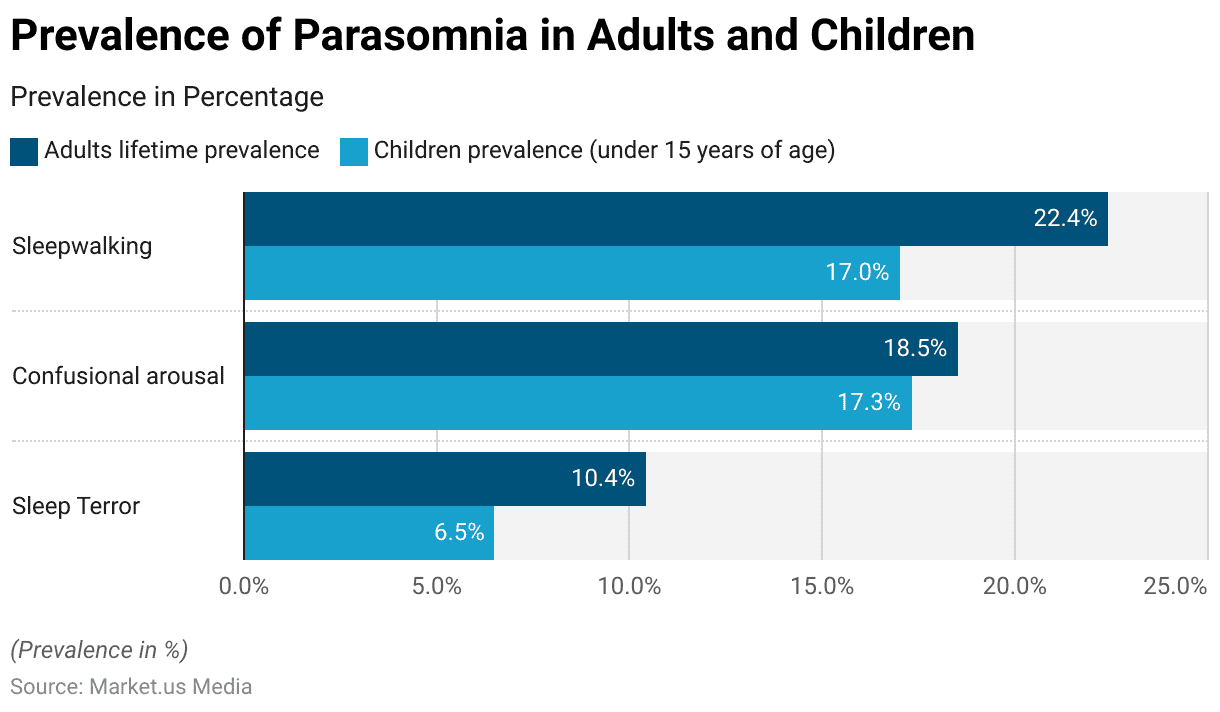
Risk Factors for Sleep Medicine Disorders Statistics
Age and Sleep Disorders
- In individuals aged less than 60 years, the prevalence of sleep disorders stands at 17.2%. While those without sleep disorders make up 43.3% of this age group.
- Conversely, in individuals aged 60 years and older, a significantly higher proportion, 82.8%, experiences sleep disorders, while 56.7% do not report any sleep disorder.
- These statistics demonstrate notable differences in the prevalence of sleep disorders between the two age groups, with a higher occurrence observed in the older population.
(Source: Research Gate)
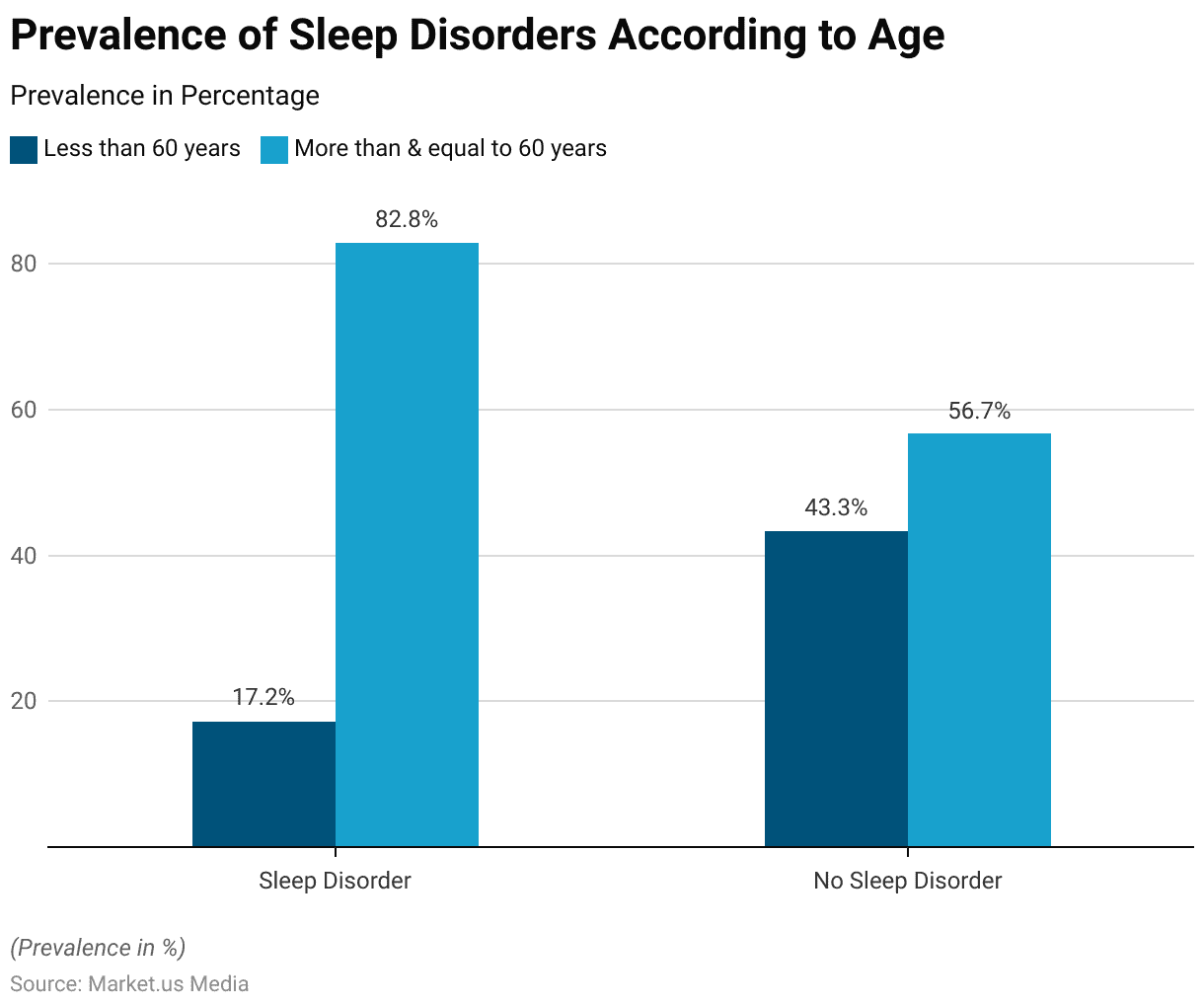
Gender Disparities
- In the United States as of 2022, the reported prevalence of select sleep issues among adults varies by gender.
- Among males, 51% reported having no trouble sleeping. While 12% reported experiencing trouble sleeping, 28% had trouble staying asleep, and 9% had difficulty both falling and staying asleep.
- On the other hand, among females, 41% had no trouble sleeping, 17% reported trouble sleeping, and 29% had difficulty staying asleep. And 13% faced challenges with both falling asleep and staying asleep.
- In the total population, comprising both genders, 46% reported no trouble sleeping, and 15% reported trouble sleeping. 28% experienced difficulty staying asleep, and 11% had trouble both falling asleep and staying asleep.
- These statistics reflect gender-based variations in reported sleep issues among adults in the United States.
(Source: Statista)
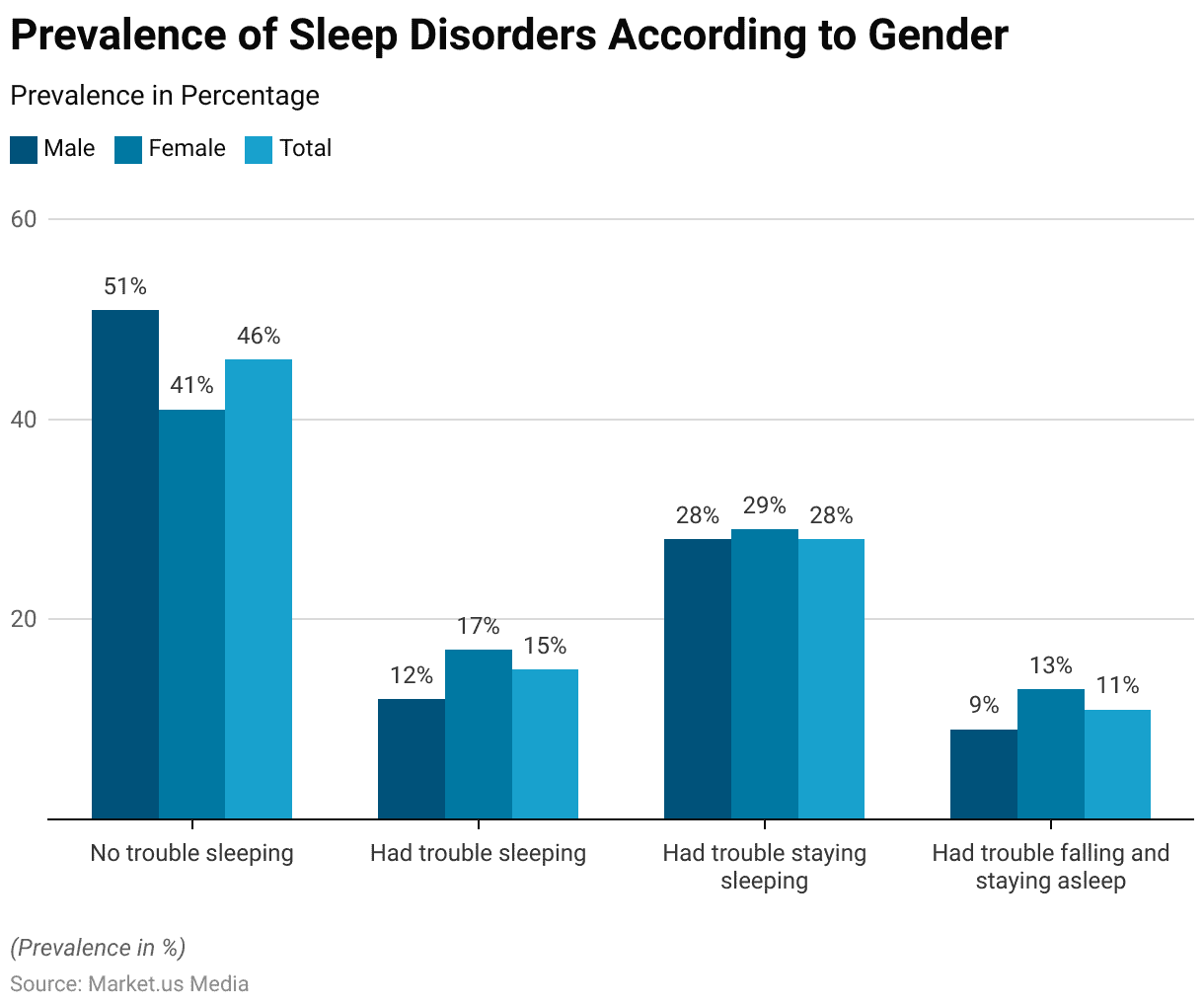
Obesity and Sleep
- In the United States, the prevalence of obesity exceeds 40%. While approximately 21% of the population is affected by a sleep disorder.
- Remarkably, among individuals diagnosed with obstructive sleep apnea. A prevalent and potentially life-threatening condition, more than 70% are also affected by obesity.
- Children need more sleep than adults because their bodies and minds are actively developing. Insufficient sleep in children can elevate their chances of developing overweight or obesity.
- Kids who don’t get adequate sleep may undergo similar hormonal shifts as adults, which can contribute to weight gain. Furthermore, it can lead to heightened daytime tiredness, potentially resulting in reduced levels of physical activity.
(Source: CDC, American Heart Association (AHA), PubMed)
Sleep Medicine Statistics for Aids and Sleep
- Approximately 8% of adults have reported using medication to assist with their sleep on at least four occasions within the past week.
- According to a survey conducted by SleepFoundation.org, 58% of individuals with seasonal affective disorder rely on sleep aids, while only 26% of those without the disorder use them.
- Additionally, 79% of adults who take prescription sleep medication encounter lingering effects such as excessive sleep, grogginess, or difficulty concentrating the following day.
- Approximately 20% of adults opt for marijuana or cannabidiol (CBD) to aid their sleep, and 23% have turned to Benadryl (diphenhydramine) as a sleep aid in the past month.
- The sleep tracker industry is anticipated to reach a substantial value of $11.2 billion by 2028, with 28% of adults utilizing cell phones, including sleep-tracking apps, to monitor their sleep patterns.
(Source: CDC, SleepFoundation.org), PubMed, American Academy of Sleep Medicine. (AASM), Research & Markets)
Demographics of Sleep Medicine Statistics
Sleep Medicine Statistics By Age Group
- The utilization of sleep medicines varies across different age groups, as indicated in the survey responses conducted by the American Academy of Sleep Medicine.
- Among adults aged 18-24, approximately 40% have reported using sleep medications. While the prevalence is slightly higher in the 25-34 age group at 45%.
- In the 35-44 age bracket, 41% have used sleep medicines, while the percentage decreases in the 45-54 age group (32%) and the 55-64 age group (34%).
- Among adults aged 65 and above, only 15% have used sleep medicines.
- Conversely, a larger proportion of individuals in the older age groups. Specifically, those aged 45 and older, reported not using sleep medicines, with percentages ranging from 61% to 80%.
- A small percentage across all age groups expressed uncertainty, with 7% or less responding that they did not know. These responses reflect variations in the use of sleep medicines across different age demographics.
(Source: American Academy of Sleep Medicine)
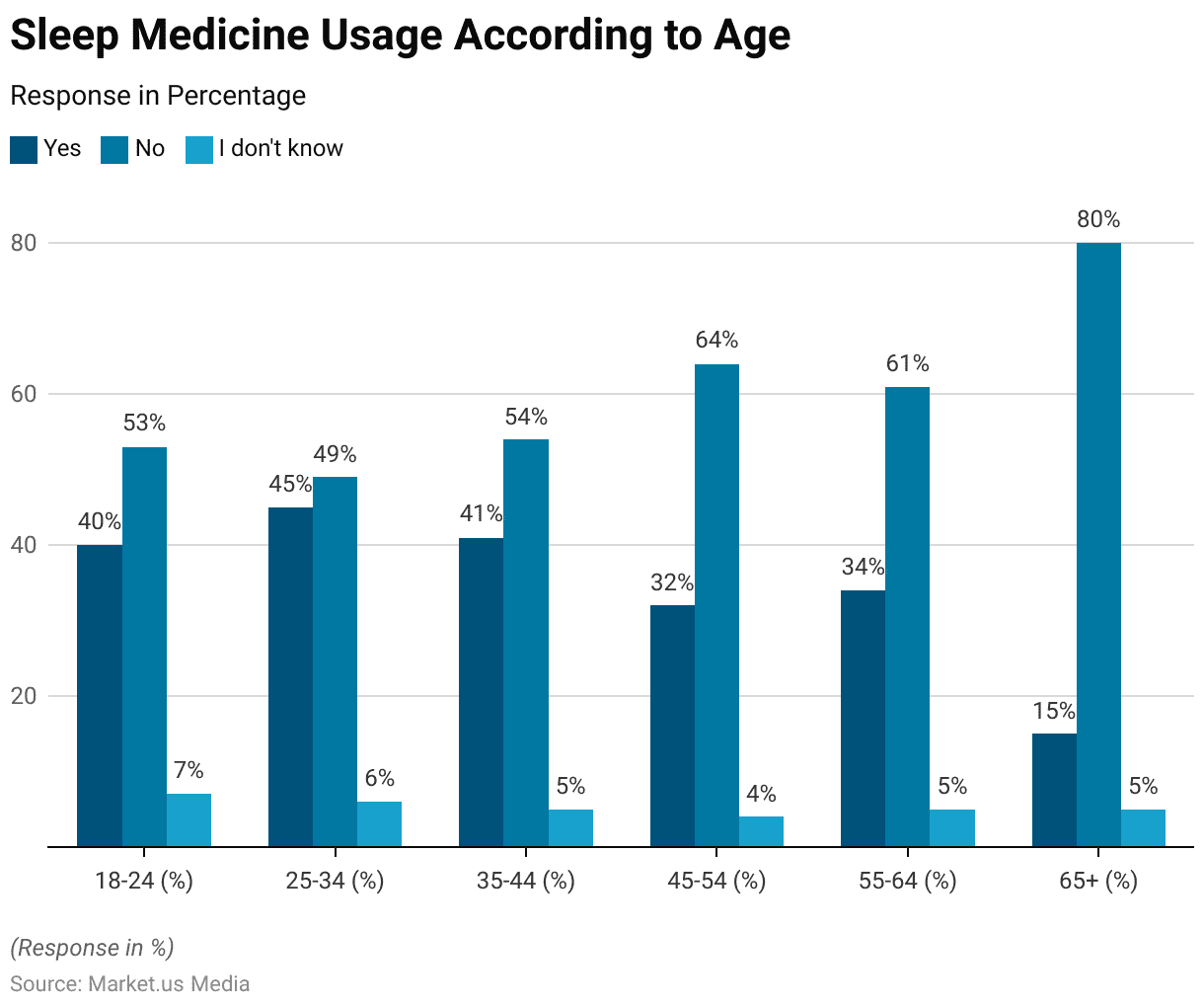
Sleep Medicine Statistics By Gender
- When it comes to the usage of sleep medicines, gender differences appear to be relatively minimal.
- Among males, 37% have reported using sleep medications, a percentage mirrored closely by females, also at 37%.
- The majority of both genders, with 58% of males and 57% of females, indicated that they do not use sleep medicines.
- A small proportion of respondents from both groups expressed uncertainty, with 5% of males and 6% of females stating that they did not know.
- These findings suggest that the use of sleep medicines is fairly consistent between males and females, with a slight variation in the percentage of those who do not use them and those who are uncertain about their use.
(Source: American Academy of Sleep Medicine)

Sleep Medicine Research Funding Statistics
- Over 12 years, the NIH’s funding for sleep research has shown a consistent and substantial increase, reflecting the growing recognition of the critical role that sleep plays in overall health and the need to address sleep-related issues.
- In 2013, the NIH allocated 229 million USD to support research projects aimed at understanding various aspects of sleep, from its underlying mechanisms to its impact on physical and mental well-being.
- As the years progressed, there was a noticeable and steady upward trend in funding.
- By 2014, the budget had already increased to 233 million USD, and this positive trajectory continued. In 2015, funding surged to 313 million USD, marking a significant boost.
- This growth continued in subsequent years, with allocations of 315 million USD in 2016, 327 million USD in 2017, and 352 million USD in 2018.
- The year 2019 saw a substantial leap in funding, reaching 436 million USD, signifying a clear commitment to advancing sleep-related research.
- This upward trajectory was maintained with allocations of 461 million USD in 2020, 493 million USD in 2021, and 520 million USD in 2022, indicating a continued dedication to studying sleep and its impact on health.
- Looking ahead, the NIH’s commitment to sleep research remains evident, with funding projected to reach 544 million USD in 2023 and 555 million USD in 2024.
(Source: Statista)
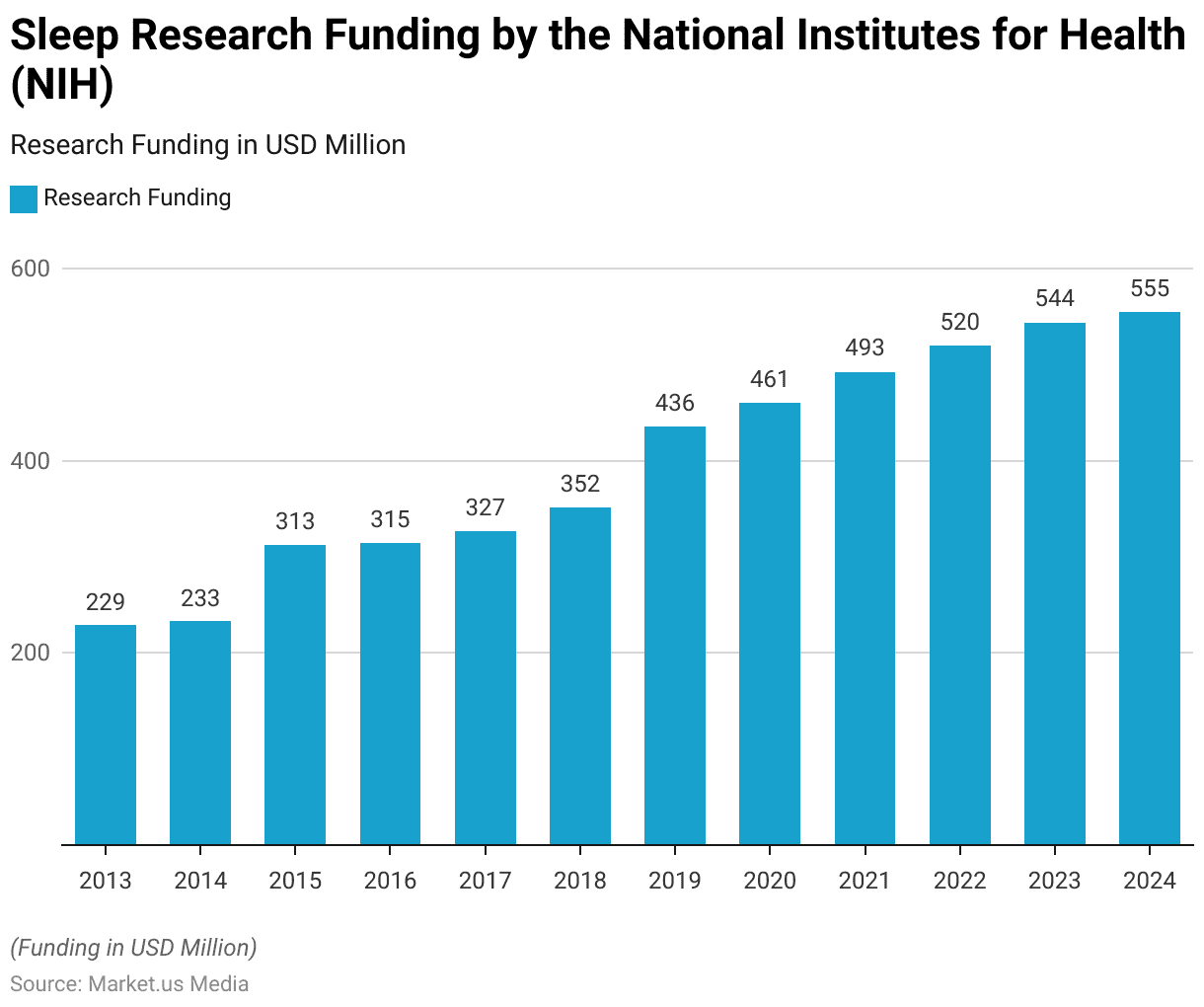
Recent Developments
Acquisitions and Mergers:
- The sleep medicine sector witnessed a notable uptick in acquisitions and mergers during the past quarter, totaling 12 transactions globally. Among these, ResMed’s acquisition of Brightree, a provider of cloud-based software solutions for sleep and homecare, for $800 million stood out, aimed at strengthening ResMed’s position in the sleep therapy market.
- Additionally, Inspire Medical Systems’ acquisition of Medtronic’s OSA business for $316 million bolstered its portfolio of obstructive sleep apnea (OSA) treatment options.
New Product Launches:
- Over the last quarter, the sleep medicine industry introduced 27 new products tailored to improve diagnosis, treatment, and management of sleep disorders. Noteworthy among these was the launch of Philips’ DreamStation 2, a CPAP (continuous positive airway pressure) device featuring enhanced comfort and connectivity options for sleep apnea patients.
- Fitbit’s release of the Fitbit Sense™ smartwatch with advanced sleep tracking capabilities, including SpO2 monitoring and sleep stage analysis, marked a significant entry into the sleep technology market.
Funding and Investments:
- Venture capital funding in sleep medicine startups reached $180 million in the last quarter, indicating growing investor interest in innovative sleep solutions. Notable investments included a $30 million funding round secured by Eight Sleep for its smart mattress technology, designed to optimize sleep quality through temperature regulation and sleep tracking.
- Moreover, public offerings in the sleep medicine sector raised approximately $420 million, with companies like ResMed and Inspire Medical Systems capitalizing on investor confidence in the growing sleep technology market.
Research and Development:
- Research and development efforts in sleep medicine have intensified, with 15% of total healthcare R&D expenditure allocated to sleep-related projects. This includes ongoing clinical trials for novel therapies targeting insomnia, sleep apnea, and other sleep disorders, aiming to address unmet medical needs and improve patient outcomes.
- Furthermore, collaborations between academia and industry have accelerated, with institutions like the National Institutes of Health (NIH) partnering with pharmaceutical companies to advance sleep research and develop innovative treatment modalities.
Prevalence and Awareness:
- The prevalence of sleep disorders continues to rise, with an estimated 70 million adults in the United States experiencing sleep problems. This has fueled a 10% increase in demand for sleep medicine services, including diagnostic sleep studies and sleep therapy devices, driving market growth.
- Despite the growing awareness of sleep health, disparities in access to sleep medicine services persist, particularly among underserved populations. Efforts to address these disparities through telemedicine initiatives and community outreach programs are underway to ensure equitable access to sleep care services.
Conclusion
Sleep Medicine Statistics – In conclusion, sleep medicine is a critical field that focuses on diagnosing and treating various sleep disorders. It plays a vital role in improving the quality of life by addressing issues that affect both physical and mental health.
With ongoing research and technological advancements, it continues to evolve, providing better solutions for those struggling with sleep-related problems.
Increasing awareness, reducing stigma, and ensuring access to care are essential in improving the well-being of individuals facing sleep challenges. Sleep medicine remains dedicated to enhancing overall health and quality of life through better sleep.
FAQs
Sleep medicine is a medical specialty focused on the diagnosis, treatment, and management of sleep-related disorders and disturbances, including insomnia, sleep apnea, narcolepsy, and more.
Sleep is essential for overall health and well-being. It allows the body to rest, recover, and rejuvenate, and it plays a crucial role in cognitive function, mood regulation, and physical health.
Common sleep disorders include insomnia (difficulty sleeping), sleep apnea (interrupted breathing during sleep), narcolepsy (sudden sleep attacks), restless legs syndrome (uncomfortable leg sensations), and parasomnias (abnormal sleep behaviors).
Sleep disorders are typically diagnosed through clinical evaluation, patient history, and various diagnostic tests such as polysomnography (sleep studies) and actigraphy. Sometimes, questionnaires and sleep diaries are also used.
Treatment options vary depending on the specific sleep disorder but may include lifestyle modifications, behavioral therapies, medications, and the use of medical devices like CPAP machines for sleep apnea.
Discuss your needs with our analyst
Please share your requirements with more details so our analyst can check if they can solve your problem(s)



